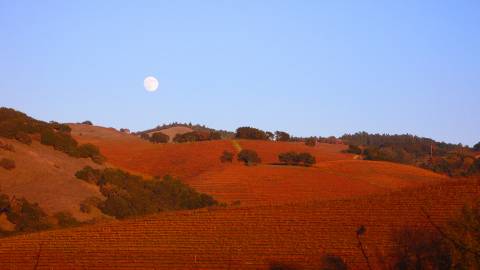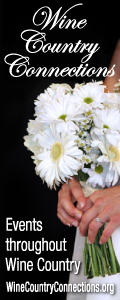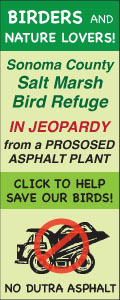Sonoma Valley Appellation Video
Playlist:
Sonoma Valley Appellation
Sonoma Valley Appellation
It is tempting to compare Sonoma Valley and Napa Valley, two narrow, inland arms of land flanked by mountain ranges with cool southern temperatures that rise as you travel northward. Both areas are defined in the public’s eye by viticulture, and most of the wineries that ring the valleys are accessible from single arteries, Highway 29 in Napa, Highway 12 in Sonoma. To tourists, this is the heart of the wine country. If they look no further, the manicured grandeur--pomposity, some might say--of Napa eclipses the understated diversity and rustic elegance that shapes Sonoma Valley
and Napa Valley, two narrow, inland arms of land flanked by mountain ranges with cool southern temperatures that rise as you travel northward. Both areas are defined in the public’s eye by viticulture, and most of the wineries that ring the valleys are accessible from single arteries, Highway 29 in Napa, Highway 12 in Sonoma. To tourists, this is the heart of the wine country. If they look no further, the manicured grandeur--pomposity, some might say--of Napa eclipses the understated diversity and rustic elegance that shapes Sonoma Valley , the birthplace of modern California viticulture. And if locals avoid the valley because it teems with tourists much of the year, they miss a trove of agricultural treasures, natural splendor, and soft spoken--and occasionally, outspoken--talent tending the land with love and innovation.
, the birthplace of modern California viticulture. And if locals avoid the valley because it teems with tourists much of the year, they miss a trove of agricultural treasures, natural splendor, and soft spoken--and occasionally, outspoken--talent tending the land with love and innovation.
The history of Sonoma Valley made its declaration as an AVA, which came in 1981, inevitable. By now the names and places are so familiar. There’s Padre José Altimi, founder of the last of the California missions, planting those first grapevines in 1823.
made its declaration as an AVA, which came in 1981, inevitable. By now the names and places are so familiar. There’s Padre José Altimi, founder of the last of the California missions, planting those first grapevines in 1823.
There’s the entrepreneurial genius of nobleman General Mariano Guadalupe Vallejo, reigning over the land and in a moment of stunning largess, deeding away what became Napa County. And there’s Count Agoston Haraszthy, that flamboyant Hungarian rogue who gave Vallejo a run for his money by importing grape vines from Europe. Even though that prescient maneuver resulted in Haraszthy being known today as the father of modern California viticulture, the rivalry between he and Vallejo remained friendly as they competed against each other in statewide and international wine competitions. Marriage—two of Vallejo’s daughters to two of Haraszthy’s sons—made them even closer, though Haraszthy wasn’t one to settle down and play with grandchildren. Off the Count went to meet his fate in a Nicaraguan river, where an alligator is said to have had the final say.
The fingerprints of these pioneers are all over the valley, but they are only part of the picture. Visits to Vallejo’s home, the old caves at Buena Vista Winery, Bartholomew Park Winery , and the historic buildings near the Downtown Plaza contribute a visceral sense of history, as does a tour of the colorful Vella Cheese
, and the historic buildings near the Downtown Plaza contribute a visceral sense of history, as does a tour of the colorful Vella Cheese Factory, where the aroma of sweet milk and the rustic wooden shelves with their golden rounds of aging cheese evoke an earlier time, so easily eclipsed by the cavernous superstores that have devoured much of our landscape. At B.R. Cohn Winery, eight acres of picholine olive trees that were planted in the late 1800s produce the premium estate oil that launched California’s contemporary olive oil renaissance. Though not accessible to the general public, remnants of the old Dunfillan Winery, the site of the first production of cabernet sauvignon in the United States, are on the vast 2000-acre Kunde Estate Winery
Factory, where the aroma of sweet milk and the rustic wooden shelves with their golden rounds of aging cheese evoke an earlier time, so easily eclipsed by the cavernous superstores that have devoured much of our landscape. At B.R. Cohn Winery, eight acres of picholine olive trees that were planted in the late 1800s produce the premium estate oil that launched California’s contemporary olive oil renaissance. Though not accessible to the general public, remnants of the old Dunfillan Winery, the site of the first production of cabernet sauvignon in the United States, are on the vast 2000-acre Kunde Estate Winery near the northern end of the Valley. (Weddings, including actress Gina Davis’s, are held at the old winery and nearby meadow.)
near the northern end of the Valley. (Weddings, including actress Gina Davis’s, are held at the old winery and nearby meadow.)
Pristine Produce
But there’s much more to Sonoma Valley ’s agricultural endeavors than it’s history and its forty or so wineries and hundreds of vineyards. On the eastern edge of Sonoma Mountain
’s agricultural endeavors than it’s history and its forty or so wineries and hundreds of vineyards. On the eastern edge of Sonoma Mountain , Bob Cannard Jr. has been growing organic produce for Chez Panisse in Berkeley for about 12 years. Twice a week, a Chez Panisse employee drives a truck-load of kitchen compost to the farm and returns to the famous restaurant with Cannard’s latest harvest. In mid-winter, there’s frisee, watercress, mache, miner’s lettuce, kale, carrots, mint, sage, savory, thyme, and more. As the season progresses, the Chez Panisse menu will feature avocados, mandarin oranges, Eureka lemons, Meyer lemons, apricots, peaches, pears, cherries, apples, prunes, table grapes, gooseberries, strawberries, currants, leeks, tomatoes, and scores of other carefully tended crops from these twenty fertile acres.
, Bob Cannard Jr. has been growing organic produce for Chez Panisse in Berkeley for about 12 years. Twice a week, a Chez Panisse employee drives a truck-load of kitchen compost to the farm and returns to the famous restaurant with Cannard’s latest harvest. In mid-winter, there’s frisee, watercress, mache, miner’s lettuce, kale, carrots, mint, sage, savory, thyme, and more. As the season progresses, the Chez Panisse menu will feature avocados, mandarin oranges, Eureka lemons, Meyer lemons, apricots, peaches, pears, cherries, apples, prunes, table grapes, gooseberries, strawberries, currants, leeks, tomatoes, and scores of other carefully tended crops from these twenty fertile acres.
When asked if this is a good growing year, Cannard responds with characteristically abrupt optimism. “With diversity in the garden, all years are good,” he insists. He also refuses to be pinned down on the idea of regional character; this is a fertile place, he declares, with the possibility of diverse agriculture throughout the entire county.
Cannard’s harvest is unavailable locally, but dozens of market gardens offer their bounty at farm stands and farmers markets. A recent move has kept Paul Wirtz of Paul’s Produce from recent markets, but we can expect his return with early spring crops around the beginning of March.
Founded in 1957 by the late Otto Teller, Oak Hill Farm and its Red Barn farm stand is one of the loveliest spots in the entire valley. In winter months, their flowers are sold at the wholesale market in San Francisco, but by May, locals can enjoy the harvest as it unfolds. The Sonoma Land Trust--Otto Teller was a founder--holds a conservation easement to the farm; there will be no more building on the 700 acres and there are plans to maintain it as a working farm. There’s another, lesser-known, piece of Teller land held by the Trust. When Otto Teller died in December of 1998, a 300-acre piece known as the “Secret Pasture” was deeded to the trust. Folklore tell us that this hidden pasture was home to Mexicans who were displaced when gringos took their land; you can’t see it from the valley, but there’s a grazing pasture with a spectacular view where the displaced farmers tended stolen livestock. Anne Teller, Otto Teller’s widow, has been joined recently by Nathan Boone, who will help with the farm’s expansion. Current plans are to double the number of the crops the farm offers, and to keep the Red Barn open year round.
and its Red Barn farm stand is one of the loveliest spots in the entire valley. In winter months, their flowers are sold at the wholesale market in San Francisco, but by May, locals can enjoy the harvest as it unfolds. The Sonoma Land Trust--Otto Teller was a founder--holds a conservation easement to the farm; there will be no more building on the 700 acres and there are plans to maintain it as a working farm. There’s another, lesser-known, piece of Teller land held by the Trust. When Otto Teller died in December of 1998, a 300-acre piece known as the “Secret Pasture” was deeded to the trust. Folklore tell us that this hidden pasture was home to Mexicans who were displaced when gringos took their land; you can’t see it from the valley, but there’s a grazing pasture with a spectacular view where the displaced farmers tended stolen livestock. Anne Teller, Otto Teller’s widow, has been joined recently by Nathan Boone, who will help with the farm’s expansion. Current plans are to double the number of the crops the farm offers, and to keep the Red Barn open year round.
An Ensemble Cast
In traditional viticulture, diversity such as this can been seen as a detriment, “the curse of versatility”, as Jancis Robinson, the British wine authority, has called it. As in Alexander Valley , nearly every grape varietal grows with a degree of success in Sonoma Valley
, nearly every grape varietal grows with a degree of success in Sonoma Valley , making it difficult to name a star performer. But perhaps we’re too celebrity driven. Does every region need a (ital) prima dona (ital)? Maybe it’s best to think of Sonoma Valley
, making it difficult to name a star performer. But perhaps we’re too celebrity driven. Does every region need a (ital) prima dona (ital)? Maybe it’s best to think of Sonoma Valley viticulture as an ensemble activity, the “Homicide” or “ER” of viticulture. There are countless outstanding wines here, from the merlots of Matanzas Creek on the western fringe of the appellation and the widely praised zinfandels of Ravenswood, to the spectacular estate cabernets of B. R. Cohn, the stalwart reds of Carmenet, Gunlach Bundschu’s robust zinfandel, and the exuberantly accessible pinot noirs and zinfandels of Kenwood. The chardonnays of Hanzell and Landmark are highly praised, those of Kunde reliably excellent year after year. Sonoma Valley
viticulture as an ensemble activity, the “Homicide” or “ER” of viticulture. There are countless outstanding wines here, from the merlots of Matanzas Creek on the western fringe of the appellation and the widely praised zinfandels of Ravenswood, to the spectacular estate cabernets of B. R. Cohn, the stalwart reds of Carmenet, Gunlach Bundschu’s robust zinfandel, and the exuberantly accessible pinot noirs and zinfandels of Kenwood. The chardonnays of Hanzell and Landmark are highly praised, those of Kunde reliably excellent year after year. Sonoma Valley clearly deserves its reputation as Sonoma County’s best known viticultural area.
clearly deserves its reputation as Sonoma County’s best known viticultural area.
Sustainable Agriculture
There is tremendous support of organic farming and sustainable practices in the valley today. Phil Coturri began farming organically here in 1979, and currently farms 250 acres, 10 of which are olives, the rest grapes, including Bordeaux varietals, syrah, sangiovese, and zinfandel. Coturri also manages other vineyards, and is currently assisting Carmenet, high in the Maya cama
cama s, with their transition to organic practices. Mike Benziger, speaking by phone from Boston, explains his family’s commitment to both a sense of place and natural farming techniques. They hope to create an enclave of environmental sensitivity, he explains, to make the winery itself a showcase where other farmers can study the techniques and equipment they’ve developed to make organic farming of mountain vineyards more feasible. They are collecting data and attempting to track wine quality scientifically. Benziger feels that natural farming techniques, elimination of pesticides and other chemicals, encouragement of deep vine roots and natural yeasts, and the composting all organic waste creates the necessary elements for the unique flavors of a place to be expressed in grapes.
s, with their transition to organic practices. Mike Benziger, speaking by phone from Boston, explains his family’s commitment to both a sense of place and natural farming techniques. They hope to create an enclave of environmental sensitivity, he explains, to make the winery itself a showcase where other farmers can study the techniques and equipment they’ve developed to make organic farming of mountain vineyards more feasible. They are collecting data and attempting to track wine quality scientifically. Benziger feels that natural farming techniques, elimination of pesticides and other chemicals, encouragement of deep vine roots and natural yeasts, and the composting all organic waste creates the necessary elements for the unique flavors of a place to be expressed in grapes.
Premium Poultry
Sonoma Foie Gras, one of two foie gras enterprises in the United States, got its start in the flatlands near the southern flanks of Sonoma Mountain . The foie gras, duck breast, and other products were among the valley’s finest, but Sonoma Foie Gras relocated to a small town near Stockton a few years ago, although they’ve kept the name. That may leave the ostrich products of Sonoma Knolls Ranch as the most exotic agricultural enterprise in the valley.
. The foie gras, duck breast, and other products were among the valley’s finest, but Sonoma Foie Gras relocated to a small town near Stockton a few years ago, although they’ve kept the name. That may leave the ostrich products of Sonoma Knolls Ranch as the most exotic agricultural enterprise in the valley.
Bob and Eleanor Franceschi have owned their Sonoma Valley land since 1972, but did not buy their first ostriches until 1994. Today they sell ostrich meats, eggs, egg shells, ostrich jerkey, and feathers at several Sonoma County farmers markets. The meat itself is heralded as low-fat, similar to beef but healthier, though it more closely resembles duck breast in taste, texture, and cooking requirements. The enormous eggs are milder and more delicate than chicken eggs; one will make tasty scrambled eggs for an entire family’s breakfast.
land since 1972, but did not buy their first ostriches until 1994. Today they sell ostrich meats, eggs, egg shells, ostrich jerkey, and feathers at several Sonoma County farmers markets. The meat itself is heralded as low-fat, similar to beef but healthier, though it more closely resembles duck breast in taste, texture, and cooking requirements. The enormous eggs are milder and more delicate than chicken eggs; one will make tasty scrambled eggs for an entire family’s breakfast.
Sonoma Valley is enjoying a period of remarkable vitality. Ramekins
is enjoying a period of remarkable vitality. Ramekins , the vibrant new cooking school was a near instant success, and has focused tremendous attention on an already popular destination. The Sonoma Cheese Factory
, the vibrant new cooking school was a near instant success, and has focused tremendous attention on an already popular destination. The Sonoma Cheese Factory is easily accessible to visitors, who can test their cheesemaking mettle by donning official garb and “rolling a wheel” as the ever-charming David Viviani likes to encourage you to do. Yet it’s still a rustic land, with grazing cattle, ancient fig trees, and the Downtown Plaza’s beloved chickens, who seem, at times, nearly as popular as Sonoma Valley
is easily accessible to visitors, who can test their cheesemaking mettle by donning official garb and “rolling a wheel” as the ever-charming David Viviani likes to encourage you to do. Yet it’s still a rustic land, with grazing cattle, ancient fig trees, and the Downtown Plaza’s beloved chickens, who seem, at times, nearly as popular as Sonoma Valley ’s esteemed wines.
’s esteemed wines.










